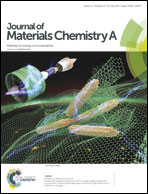Photovoltaic performance of long-chain poly(triphenylamine-phenothiazine) dyes with a tunable π-bridge for dye-sensitized solar cells
Abstract
A set of conjugated polymers based on poly(triphenylamine-phenothiazine) with carboxylic acid side groups have been synthesized and utilized as sensitizers for dye-sensitized solar cells (DSSCs). The polymers feature a conjugated side-chain consisting of a thiophene unit (PPAT4), alternating with either 3,4-ethylenedioxythiophene (EDOT, PPAT5) or EDOT–thiophene (PPAT6) as the π-bridge. This methodology constitutes a consolidated step to adjust the molecular HOMO and LUMO energy levels of dyes, hence red-shifting and broadening the absorption spectra of a conjugated polymer. Compared with the model compound (PAT), the polymers exhibit a higher molar extinction coefficient throughout the visible region, and a better photovoltaic performance in DSSCs with I−/I3− electrolyte. Interestingly, depending on the Suzuki coupling reaction, we obtain a fairly high degree of polymerization (DP values are 58, 46, and 38 for PPAT4, PPAT5 and PPAT6, respectively) based on the three polymers. More encouraging is that when using the high DP polymers as sensitizers, photoelectrochemical tests based on the DSSC format demonstrate a power conversion efficiency of 4.7%, 3.7% and 4.1% for PPAT4, PPAT5 and PPAT6, respectively, under the illumination of AM1.5G and 100 mW cm−2. This presented a considerably high photo-to-electric conversion efficiency in polymer dye-sensitized solar cells, outperforming all polymer dye-sensitized solar cells previously reported.


 Please wait while we load your content...
Please wait while we load your content...